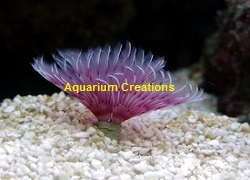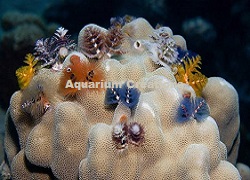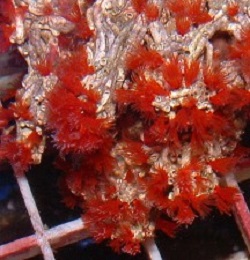Red Feather Duster
Bispira sp.

Description:
Colourful, hardy and peaceful toward virtually all other reef tank inhabitants, these forgiving Red Feather Dusters are perfect for first-time reef-keepers but still able to start conversations among old-timers. If you have ever been fortunate enough to experience the mesmerizing effects of watching a feather duster retract with lightening quickness into its protective tube, you know what all the hubbub is about when it comes to this intriguing marine invertebrate. The umbrella-like crown, consisting of roughly 30 feathery radioles, or gills, of the red feather duster can reach 2 or 3 inches in diameter, when extended fully outward. The individual feathers are red and white. By waving its radioles, the red feather duster creates its own gentle water movement that guides minute bits of plankton from the water column onto sticky tentacles and into its mouth, which is located in the center of the crown. The radioles of these unusual, segmented marine worms not only capture and provide food, but they aid in breathing too. Hawaiian feather dusters secrete mucous that bits of substrate adhere to and that produces a cocoon-like structure, described as being similar in look and feel to heavy paper or leather.
Tank Recommendations:
When feeding the red feather duster, turn off protein skimmers for about one hour to make sure targeted food stays put. Likewise, intermittent stirring of the sandbed helps to suspend settled detritus back up into the water column where the worms can access it. While the Hawaiian feather duster is totally reef compatible, it may fall prey to aggressive fishes (e.g., dwarf angelfishes, some sea stars, etc.). They do best with peaceful fishes and invertebrates. Sandy, rubbly substrate assists feather dusters in building their tubes, while rock work is important for them to affix themselves to. Special note: The red feather duster may drop its crowns if stressed. This is no cause for alarm as the crown will regenerate in time, although the source of the stress should be found and removed.
Food and diet:
Feed marine snow, phytoplankton, and/or foods for filter feeders.
Level of Care: Easy
Reef Compatibility:
Excellent
Approximate Purchase Size:
3" to 5"
|
Price Each $19.99 ea.
|
Multicolored Christmas Tree Worm Rock
Spirobranchus giganteus

Description:
Also known as Jewel Stone, Christmas Worm Rock is a coral, usually Porites sp., that is colonized by a variety of colorful tube worms with spiraling crowns shaped like a christmas tree, hence the name. When disturbed or startled, these little worms will retreat quickly into their hidden tubes. The worm is aptly named, both its common and Latin names refer to the two chromatically hued spiral structures, the most common feature seen by divers. The multicolored spirals are highly derived structures for feeding and respiration. Spirobranchus giganteus is similar to most tube-building polychaetes. It has a tubular, segmented body lined with chaeta, small appendages that aid the worm's mobility. Because it does not move outside its tube, this worm does not have any specialized appendages for movement or swimming. The worms' most distinct features are two "crowns" shaped like Christmas trees. These are highly modified prostomial palps, which are specialized mouth appendages. Each spiral is composed of feather-like tentacles called radioles, which are heavily ciliated and cause any prey trapped in them to be transported to the worm's mouth. While they are primarily feeding structures, S. giganteus also uses its radioles for respiration; hence, the structures commonly are called "gills." One major difference between Christmas tree worms and the closely related sabellida fan worms is that the latter do not have any specialized body structures to plug their tube holes when they withdraw into them. S. giganteus, like other members of its family, possess a modified radiole, usually called the operculum, that it uses to secure its hole when withdrawn into its tube. As an annelid, S. giganteus possesses a complete digestive system and has a well-developed closed circulatory system. Like other annelids, these worms possess well-developed nervous systems with a central brain and many supporting ganglia, including pedal ganglia, unique to the Polychaeta. Like other polychaetes, S. giganteus excrete with fully developed nephridia. When they reproduce, they simply shed their gametes straight into the water where the eggs (and spermatozoa) become part of the zooplankton to be carried by the currents. Each rock will have a variable number of worms and a variable number of colors, and the coral rock will also vary in shape and color.
Tank Recommendations:
The Christmas Tree Worm is somewhat shy of movement and prefers to be under the cover of rocky overhangs, out of the bright light and direct strong water flow. The Christmas Tree Worm does need a lot of medium water flow in order to feed on plankton or liquid plankton-based foods within the currents. It is very intolerant of copper-based medications. This species does not readily breed in the aquarium environment and cases of this occurring are very rare.
Food and diet:
Feed marine snow, phytoplankton, and/or foods for filter feeders.
Level of Care: Easy
Reef Compatibility
:Excellent
Approximate Purchase Size:
Small: 1" to 2"; Medium: 2" to 3-1/2"; Large: 3-1/2" to 5"
|
Small $59.99 ea.
Medium $79.99 ea.
Large $109.99 ea.
|
Bright Red Christmas Tree Worm Rock
Spirobranchus sp.

Description:
The Bright Red Christmas tree rock is colonized grouping of red tube worms with red spiraling crowns. Wehen disturbed or startled, these little worms will retreat quickly into their hidden tubes. Each rock will have a variable number of worms.
Tank Recommendations:
The Bright Red Worm is somewhat shy of movement and prefers to be under the cover of rocky overhangs, out of the bright light and direct strong water flow. The Red Worm does need a lot of medium water flow in order to feed on plankton or liquid plankton-based foods within the currents. It is very intolerant of copper-based medications. This species does not readily breed in the aquarium environment and cases of this occurring are very rare.
Food and diet:
Feed marine snow, phytoplankton, and/or foods for filter feeders.
Level of Care: Easy
Reef Compatibility
:Excellent
Approximate Purchase Size:
Small: 1" to 2"; Medium: 2" to 3-1/2"; Large: 3-1/2" to 5"
|
Small $39.99 ea.
Medium $59.99 ea.
Large $89.99 ea.
|



